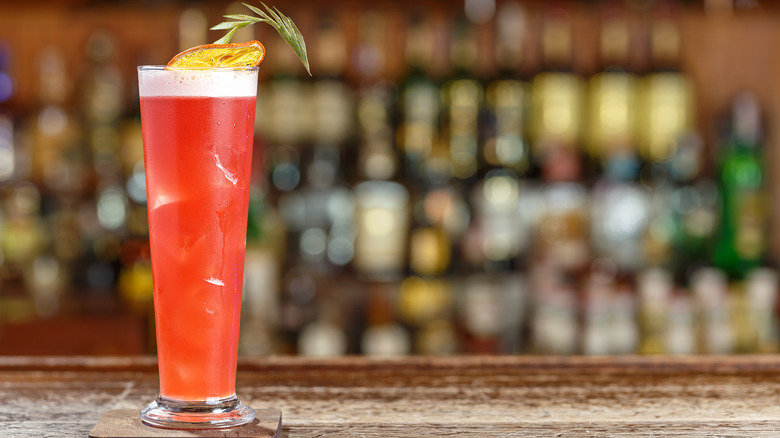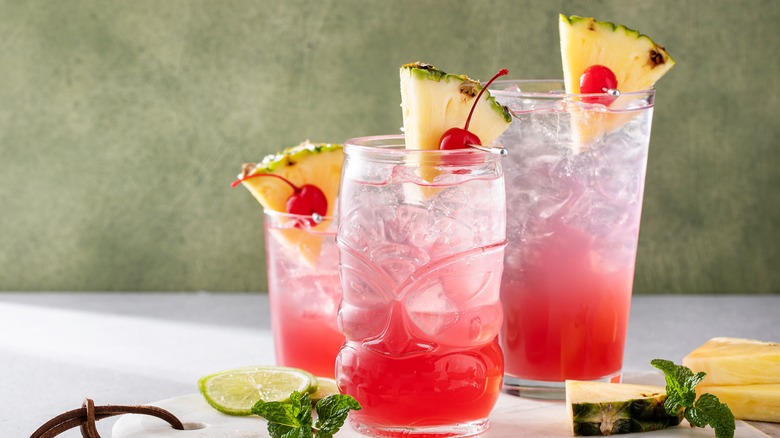Singapore Vs Gin Slings: The Difference Between The Two Cocktails
It can be easy to find yourself mixed up when deciding between drinks at your favorite cocktail bar — especially when two options sound similar or fall into the same category. You may have found this to be the case when faced with the choice between a gin sling and a Singapore sling.
Although these two cocktails share a base spirit and general framework, they quite differ in composition. A classic sling has a base spirit (like gin, brandy, whiskey, or rum) combined with lemon juice (preferably fresh) and simple syrup or sugar, and those ingredients are shaken and finished with soda water. The gin sling is a relatively classic representation of that style.
The Singapore Sling, on the other hand, takes things in a fruitier direction with cherry brandy, pineapple, and lime, as well as additional liqueurs like Cointreau and Benedictine. And while the Singapore Sling is the only drink of the two to include aromatic bitters, its flavor profile is considerably sweeter thanks to the other elements, including grenadine syrup (which also earns it a distinctive pinkish hue), while the gin sling is clear (not unlike a perfect gin and tonic). Their garnishes may also be distinguishing, with a simple lemon or lime for the gin sling, and a showier selection of fruit, including, at times, pineapple and cherry for the Singapore.
Singapore Sling spins
This basic understanding may help you decide on your order, but you might still wind up running into some differences within the same drink — particularly with the Singapore Sling. This cocktail is believed to be a riff built upon the gin sling, dreamed up at the turn of the 20th century in its namesake city at the Raffles Hotel. And as is often the case with cocktail histories, the particulars of its creation and evolution are contested — including its ingredients and ratios. In his 1948 cocktail book "The Fine Art of Mixing Drinks," author David A. Embury wrote, "Of all the recipes published for this drink, I have never seen any two that were alike."
While many variations are subtle (frequently, the distinction is differentiation in ratio or the amount of a particular ingredient from bar to bar), others are more pronounced. Famed San Francisco bar Smuggler's Cove, for example, offers a slight twist that omits the pineapple juice and Cointreau altogether, instead using orange bitters. On the other hand, some interpretations considerably simplify the Singapore, using only gin, Benedictine, cherry liqueur, and soda water, making for a dryer drink. With that in mind, if you plan to sling your own drinks at home, you won't be the only one making modifications to suit your palate.
Slingin' through history and at home
Whipping up your own sling will include you in a long liquid legacy. This category of cocktails has been around for centuries, since back in the 1700s when they were crafted with a spicy kick — often thanks to the inclusion of nutmeg. The name has nothing to do with a bartender slingin' drinks, though; it's a derivative of the German word schlingen, which, translated, means "to swallow," perhaps because of its easy drinkability. Slings can also be served hot (similar to a classic hot toddy), and there's even a definitive sling glass, which is tall and footed.
Today, you can find and create slings freely and efficiently; they are simple to riff on, given their standard formula. With the classic gin sling, you can use an infused syrup or a flavored spirit, swap the soda water for a ginger ale or tasty seltzer (or double down on the booze with a hard seltzer), exchange lemon juice for grapefruit or another citrus and garnish with herbs like basil or mint for aroma, flavor, and aesthetic. If you are searching for inspiration to personalize a Singapore Sling, look to programs that go for extra creative flourishes, swapping out the grenadine for Thai basil syrup, and switching out pineapple for lychee or rhubarb. No matter which direction you choose, these drinks are iconically delicious.


